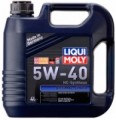Type
-
Mineral. The name of this type is due to the fact that the oil is entirely of “fossil” origin - its components are hydrocarbons obtained during the distillation of oil. This type of oil appeared first and is still used today, however, it is gradually losing ground to synthetics and semi-synthetics. This is due to the fact that pure mineral oils are significantly inferior in characteristics to these two types. In particular, they do not tolerate both high and low temperatures - they can thicken and even freeze at -15...-20 ° C, and when they boil, they severely clog the engine. Oxidation of such oil occurs faster, which requires more frequent replacement. In addition, many modern engines put forward quite stringent requirements for the quality of fuels and lubricants, into which mineral oils simply do not fit. On the other hand, brands of this type are easy to produce and inexpensive.
—
Synthetics. Such oils are produced artificially, using chemical synthesis (hence the name). They appeared as a means of overcoming the shortcomings of mineral varieties and have proven themselves to be excellent in this role, because The technology for the production of synthetic oils makes it possible to create liquids with almost any characteristics - resistant to cold, not prone to oxidation, a certain viscosity, etc. On the other hand, this technology is quite complex and expensive, which consequently affects
...the price of the product.
- Semi-synthetic. Such brands of oil are mixtures of mineral and synthetic components and, accordingly, are a cross between the two types described above. They are much cheaper than purely synthetic oils, and although they are inferior in characteristics, they are in many ways superior to purely mineral products. Semi-synthetics are considered the best option for cases where oil consumption is high, but mineral varieties cannot be used - for example, if you often have to drive long distances in cold weather, or if the engine in a car for long trips has high demands on the quality of the lubricant.
— Flushing. Low-viscosity motor oils with a special package of detergent additives based on potent chemicals, used to maintain the internal components of the power unit in proper cleanliness, remove varnish deposits, accumulated dirt and slag, and neutralize acids formed in the engine. Flushing compounds are recommended for use when switching from one oil to another (based on base, viscosity or manufacturer), when purchasing a used car with an unknown service history, when there are visible carbon deposits under the valve cover, and under severe operating conditions of the engine.SAE
The degree of oil viscosity, determined according to the international SAE standard. Viscosity is one of the key physical characteristics of an oil that determines its compatibility with a particular engine. Most modern brands of oil are all-weather and are designed for use, incl. and at low temperatures. Therefore, the SAE index for them includes information not only on the viscosity characteristics in a warm engine, but also on frost resistance.
Such an index is usually written in the form of two digits separated by the letter w:
0w-8,
0w-12,
0w-15,
0w-16,
0w-20,
0w-30,
0w-40,
0w-50,
5w-20,
5w -30,
5w-40,
5w-50,
5w-60,
10w-30,
10w-40,
10w-50,
10w-60,
15w-40,
15w-50,
15w-60,
20w-20,
20w-50,
20w-60,
...25w-40. There is also the format SAE 10w, SAE 20, SAE 30, SAE 40 and SAE 50. The first number describes only the cold resistance of the oil, and does not apply to its properties when the engine is warm. If 35 is subtracted from this number, you get the minimum temperature at which the engine can be cranked over to start. In our example, this temperature will be 15-35=-20 °C. Of course, such values are rather arbitrary, because In practice, other factors must also be taken into account. For example, with a “dead” battery (which is not uncommon in cold weather), a cold start can cause difficulties even at a higher temperature than follows from the characteristics of the oil.
The second number determines the characteristics of the oil in a warm engine in normal mode, at normal operating temperatures. It is this indicator that is the main one for choosing a brand of lubricant for a particular car - you must strictly adhere to the manufacturer's recommendations. The fact is that each engine is designed based on strictly defined viscosity values. An oil that is too viscous will linger in large quantities in moving parts, and one that is too fluid will leave them without lubrication at all; In both cases, power drops and wear increases. Therefore, first of all, when choosing according to SAE, the second number and its correspondence to the characteristics of the engine should be taken into account.Approvals Audi, VW, Skoda, SEAT
An engine oil quality standard that VAG considers essential for correct operation when used in the engine of its vehicles. For various engines (respectively, car brands) there is a standard, among which there are
500.00,
501.01,
502.00,
503.00,
503.01,
504.00,
505.00,
505.01,
506.00,
506.01,
507.00,
508.00, and
508.00 ,Porsche approvals
An engine oil quality standard that Porsche considers essential for correct operation when used in the engine of its vehicles. For various engines (respectively, car brands) there is a standard, among which are
A40,
C20,
C30 and
C40.
BMW, MINI approvals
The quality standard of motor oil, which the manufacturer BMW considers mandatory for correct operation when used in the engine of its cars. For different engines (and accordingly, car brands) there is a standard, among which are
Longlife-98,
Longlife-01,
Longlife-04,
Longlife-12 FE,
Longlife-14 FE+,
Longlife-17 FE+,
Longlife-19 FE,
Longlife-22 FE++.
Approvals Mercedes-Benz
An engine oil quality standard that Mercedes-Benz considers essential for correct operation when used in the engine of its vehicles. For different engines (respectively, car marks) provides its standard, among which there are
226.5,
226.51,
226.9,
228.5,
229.3,
229.5,
229.5,
229.5, 229.5, 229.5,
229.7,
229.5,
229.5,
229.5,
229.3,
229.5,
229.31 , 229.5
